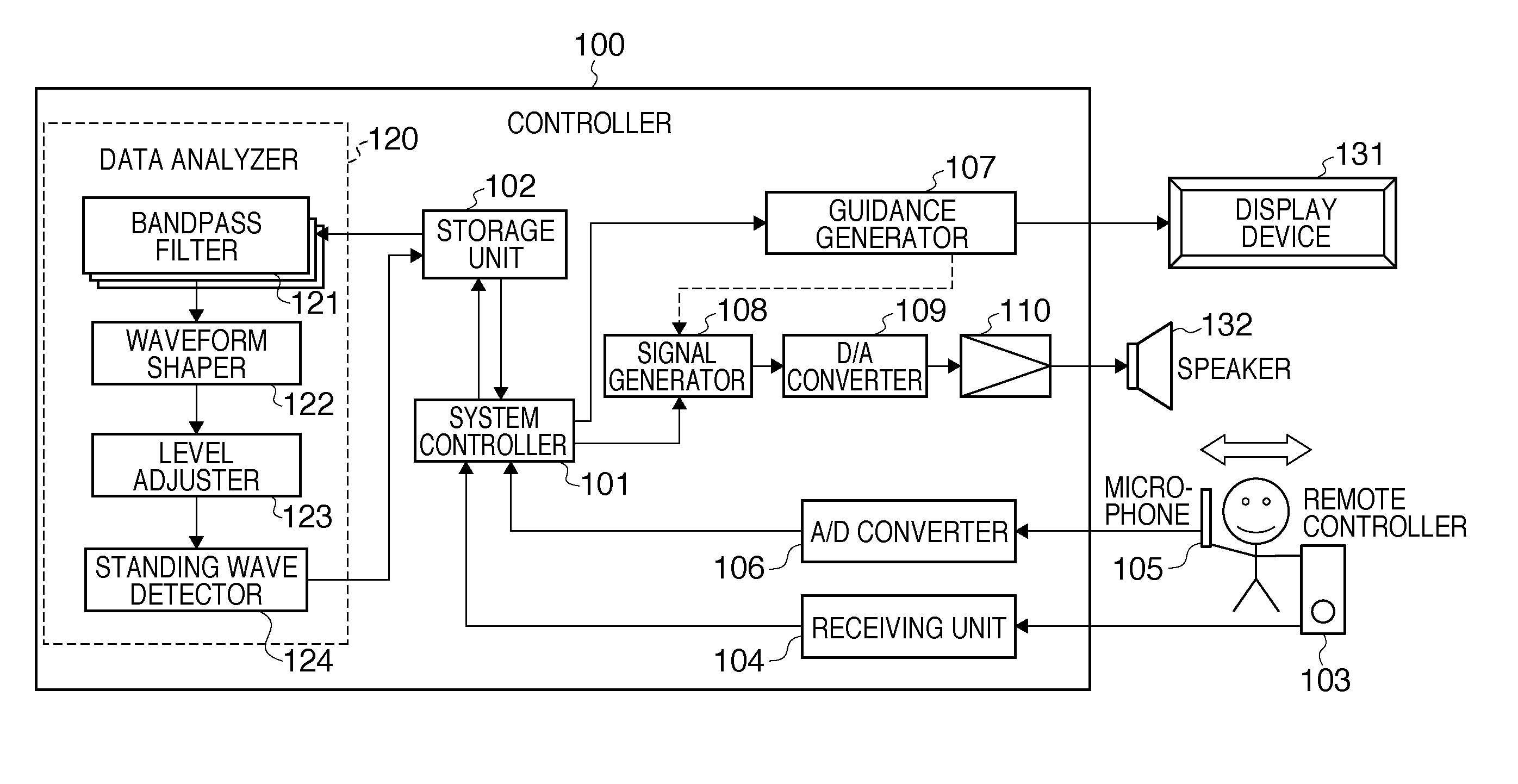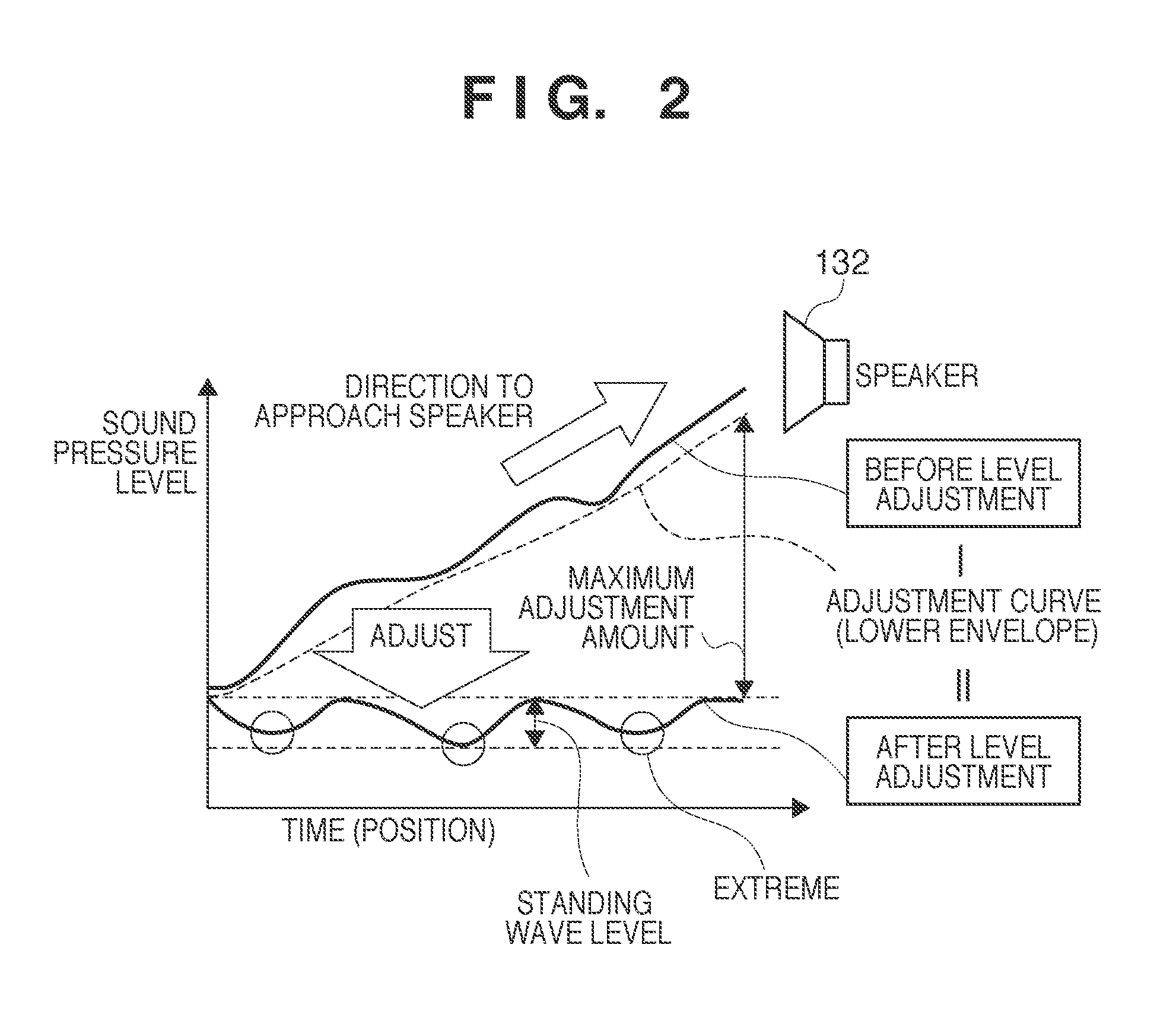Standing wave detection apparatus and method of controlling the same
a technology of standing wave and detection apparatus, which is applied in the direction of reverberation time, instruments, measurement devices, etc., can solve the problems of increasing the load on the user, difficult to detect the frequency of all standing wave generated in the listening area, and requiring long time, so as to achieve efficient detection of standing wave generated
- Summary
- Abstract
- Description
- Claims
- Application Information
AI Technical Summary
Benefits of technology
Problems solved by technology
Method used
Image
Examples
first embodiment
[0038]A standing wave detection apparatus according to the first embodiment of the present invention will be described below by exemplifying a standing wave detection apparatus for performing measurement while moving in a predetermined space.
[0039]Measurement (to be referred to as “mobile measurement” hereinafter) while moving in a predetermined space such as a room is a method of performing measurement continuously at positions while moving a microphone without stopping at each measurement point. FIG. 20 is a graph showing examples of sound pressure level (200-Hz component) measurement results in fixed-point measurement and mobile measurement. Reference numeral 2000a indicates a fixed-point measurement result; and 2000b and 2000c, mobile measurement results. Note that since the results 2000b and 2000c are obtained by measurement while moving, the abscissa represents both the position and the measurement time. Comparing the results 2000a and 2000b reveals that the dip near the cente...
second embodiment
[0070]In the second embodiment, a standing wave detection apparatus having a level adjuster different from that of the first embodiment will be described. Note that the remaining components and operations are the same as in the first embodiment, and a description thereof will not be repeated.
[0071]
[0072]FIG. 6 is a block diagram showing a level adjuster 600 according to the second embodiment. Unlike the first embodiment, the level adjuster 600 includes a maximum adjustment amount determiner 601 as a processing block.
[0073]As described in the first embodiment, a level adjuster 123 removes a variation in the level caused by the distance between a speaker 132 and a microphone 105 from sound pressure level data. If the adjustment amount at that time is too large, it indicates that the measurement position of the microphone 105 is too close to the speaker 132. At this time, since the direct sound from the speaker 132 is superior to the reflected sound from the walls, the peaks and dips o...
third embodiment
[0077]In the third embodiment, a standing wave detection apparatus having a standing wave detector different from that of the first embodiment will be described. Note that the remaining components and operations are the same as in the first embodiment, and a description thereof will not be repeated.
[0078]
[0079]FIG. 8 is a block diagram showing a standing wave detector 800 according to the third embodiment. Unlike the first embodiment, the standing wave detector 800 includes an extreme interval determiner 801 as a processing block.
[0080]As described in the first embodiment, a standing wave detector 124 detects the variation range (standing wave level) and extrema of sound pressure level data adjusted by a level adjuster 123, thereby detecting standing waves. An extreme is a local minimum or local maximum which preferably appears every half wavelength of a wavelength determined by the frequency of a standing wave, i.e., the extrema preferably have a predetermined interval.
[0081]Howeve...
PUM
 Login to View More
Login to View More Abstract
Description
Claims
Application Information
 Login to View More
Login to View More - R&D
- Intellectual Property
- Life Sciences
- Materials
- Tech Scout
- Unparalleled Data Quality
- Higher Quality Content
- 60% Fewer Hallucinations
Browse by: Latest US Patents, China's latest patents, Technical Efficacy Thesaurus, Application Domain, Technology Topic, Popular Technical Reports.
© 2025 PatSnap. All rights reserved.Legal|Privacy policy|Modern Slavery Act Transparency Statement|Sitemap|About US| Contact US: help@patsnap.com



